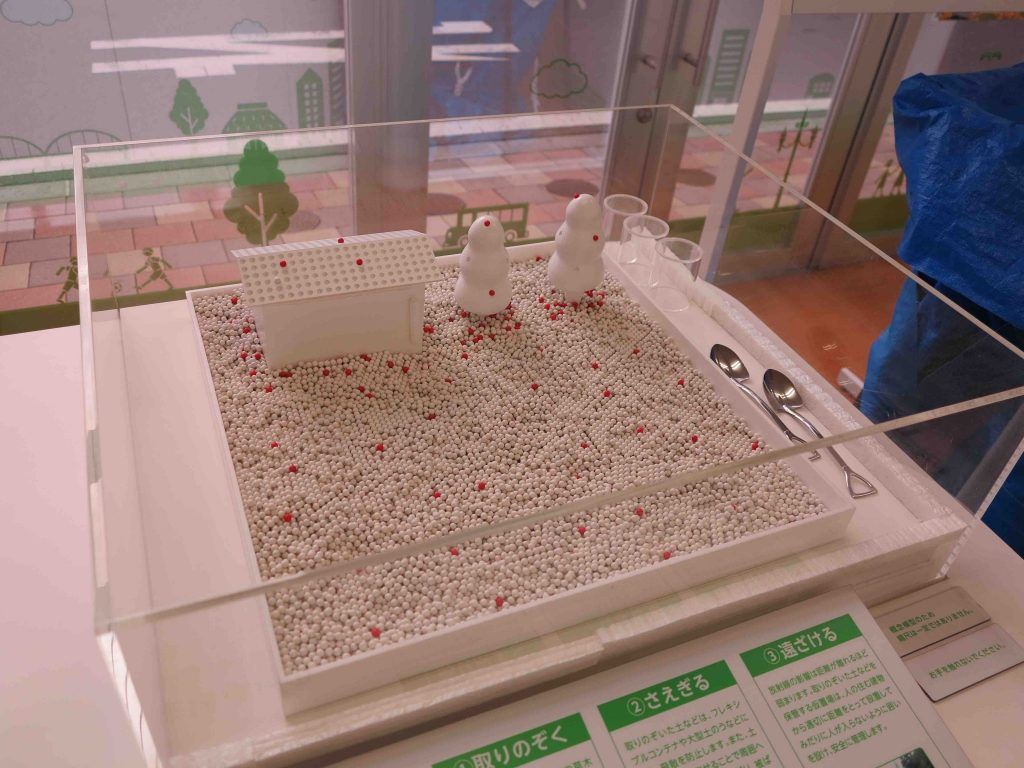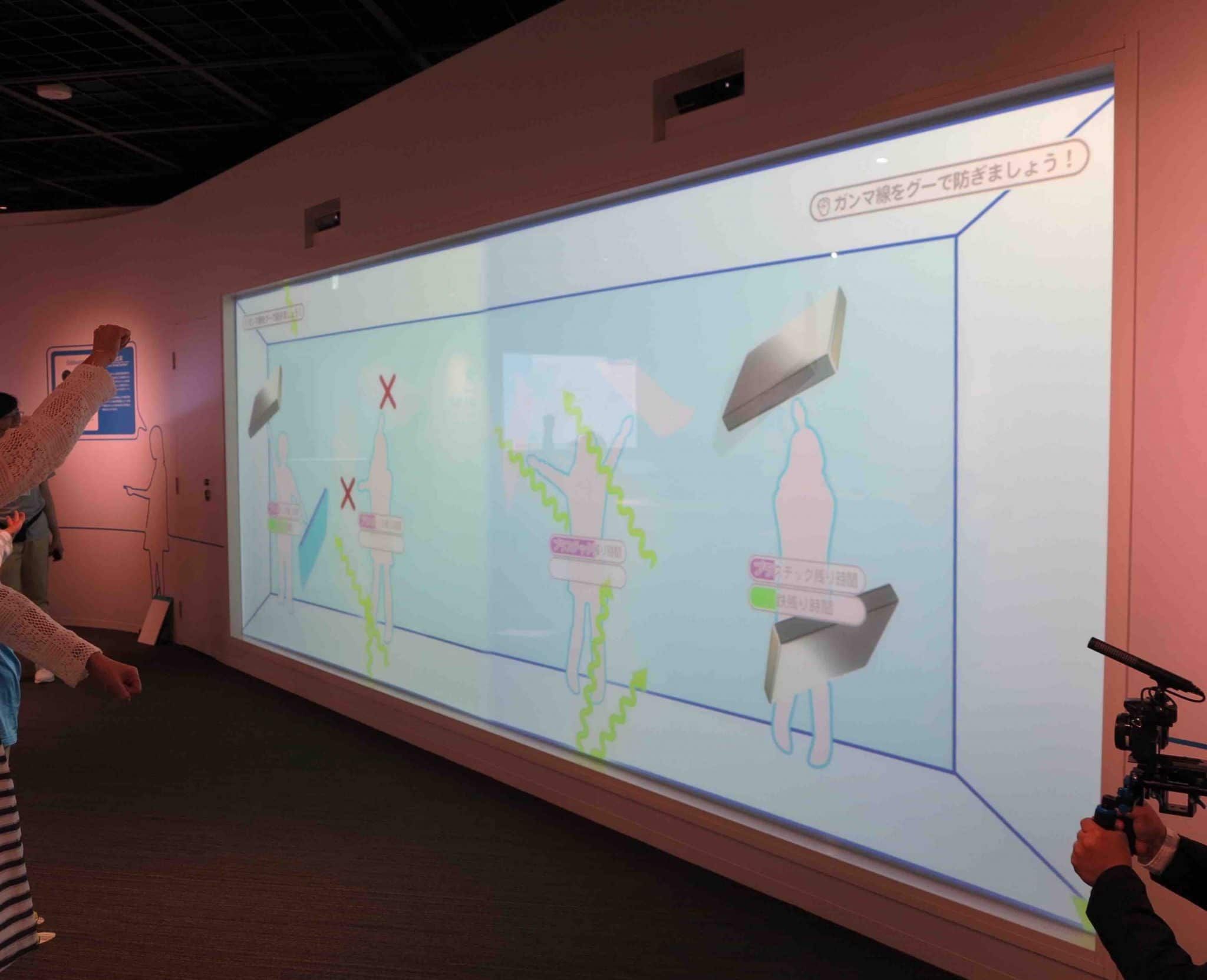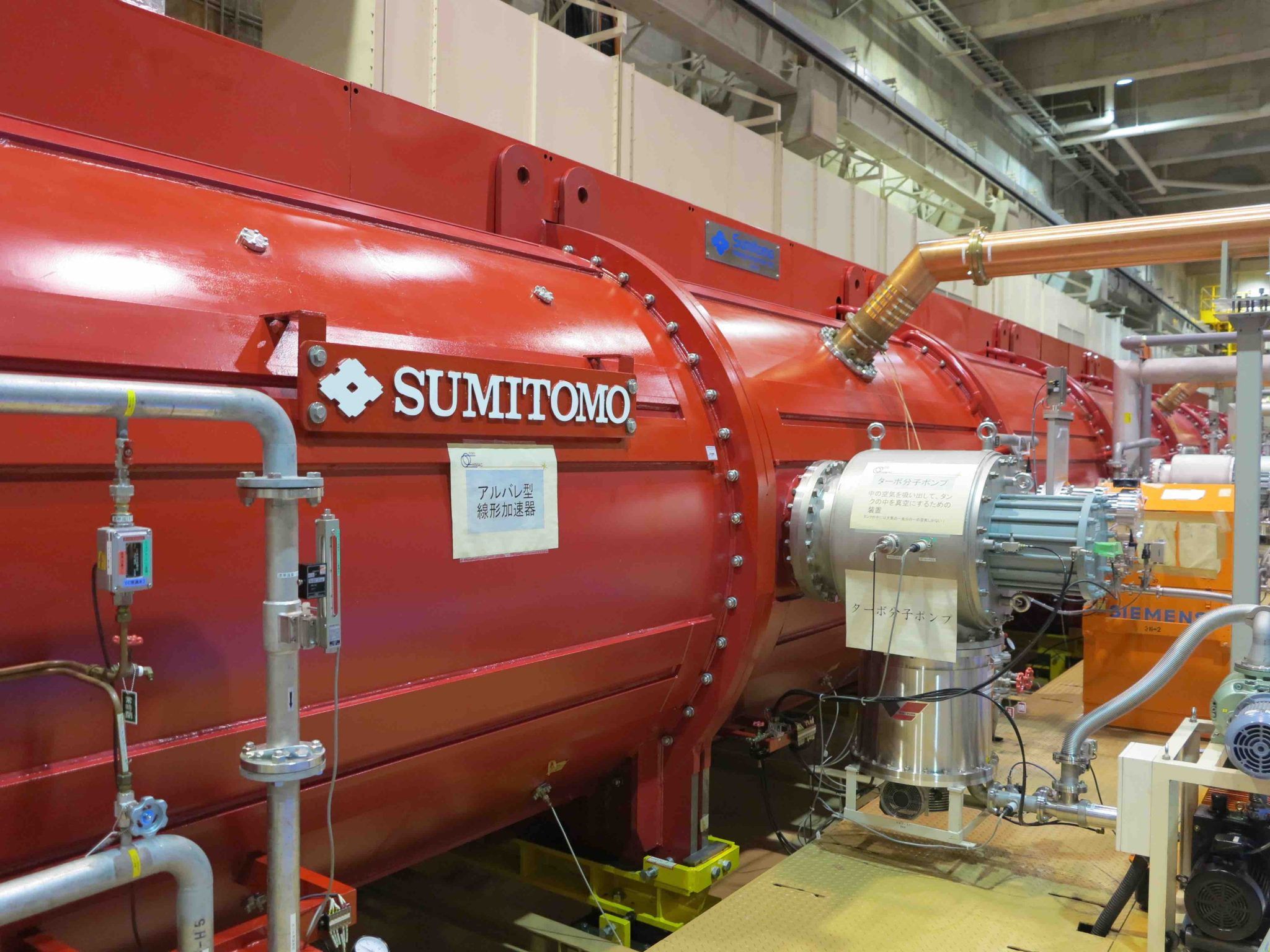Teaching about radiation after Fukushima
By Maxime Polleri | February 26, 2019
 An interactive model at the Decontamination Info Plaza in the city of Fukushima allows visitors to “decontaminate” a house and yard. Credit: Maxime Polleri
An interactive model at the Decontamination Info Plaza in the city of Fukushima allows visitors to “decontaminate” a house and yard. Credit: Maxime Polleri
At the entrance to the Fukushima Prefectural Centre for Environmental Creation, a friendly hippopotamus-like mascot welcomes visitors while accepting hugs from children. Buzzing with young families, this government-sponsored scientific hub was created to explain the phenomenon of radiation to the population of Fukushima, the victims of the eponymous 2011 nuclear disaster.
Inside the main annex, an interactive model explains how external radiation exposure can be lowered. Visitors are encouraged to increase their distance from a radiation-emitting device while making use of shielding, thereby lowering their overall exposure. In another corner, children are learning about the radioactive isotopes released during the disaster, although representations of these perils are anything but threatening. Using posters and comic books, radionuclides such as plutonium‑239 and cesium‑137 are represented as adorable anthropomorphic figures. Each radionuclide has its own characteristics, such as pronounced eyebrows or a distinctive hairstyle. There is no discussion about how exposure to these radionuclides can cause serious bodily harm—an increased risk of cancer, for example.
In the aftermath of the Fukushima meltdowns, which triggered a released of radioactive pollutants, the Japanese state initially decided to increase the mandatory evacuation trigger from 1 millisievert of radiation exposure per year to 20 millisieverts per year. In other words, the public was forced to accept a new threshold of safety. While this policy caused much scientific and public controversy, 20 millisieverts per year remains the benchmark for what is considered safe in Fukushima. Places like the Centre for Environmental Creation downplay the controversy of a raised threshold of exposure.
Situated in the town of Miharu and opened in July 2016, the center was established by the prefecture of Fukushima, with the financial support of the Japanese government, to conduct research and provide education on radioactive contamination. The center is one of several government-sponsored revitalization projects aimed at rebuilding the trust of people living in Fukushima. Mostly visited by young families, it represents a new approach to risk communication. As a technical advisor explained to me, this approach aims to “deepen the understanding of children about radiation” by allowing visitors to experience information firsthand through interactive games, fun activities, and cute presentations.
Past efforts to present nuclear science in appealing ways have often blended education with propaganda. The 1957 Disney TV episode Our Friend the Atom is a perfect example of this. What are the dangers of resorting to such forms of explanations in the aftermath of a nuclear disaster? In 2015 and 2017, I spent a total of 14 months in Japan examining the public’s interactive experience at state-sponsored centers and public activities that explain radiation. I found that while the information on radiation is easy to understand, many aspects of its hazards are carefully concealed. In particular, the government’s educational approach shifts the post-Fukushima Japanese public’s attention away from manmade danger and toward a vision of naturalness, technological amusement, and scientific amazement. In doing so, this approach downplays the risk inherent to residual radioactivity in Fukushima.
The naturalness of radiation. One way to neutralize the perceived harmfulness of radiation is to make the phenomenon appear as natural as possible, by emphasizing the radioactivity coming from natural sources. At the Centre for Environmental Creation, one of the most popular attractions is an enormous spherical theater, where visitors are bombarded with sounds and images in a 360-degree multisensory experience that describes radiation as a natural part of daily life. “It can be found everywhere! From the sun’s ray to the mineral in the earth,” claims the theater’s narrator. “Without radiation, no life would exist on Earth!” After these explanations, an enormous Boeing passes above theatergoers’ heads in the cinematic sky, and the amount of radiation exposure received during an intercontinental flight is said to be higher than the level of radiation found in Fukushima. Their necks strained upward, visitors mumble words of apparent relief.
What the theater fails to explain, however, is that there is nothing natural about the radioactive isotopes released during the Fukushima nuclear disaster, and that background radiation has little to do with the hazards of breathing or swallowing fission products—which are not rays, but dust-like particles. For instance, strontium 90, if inhaled or ingested, mimics calcium to enter an individual’s bone marrow and cause lifelong radiation exposure. This exposure can cause mutations in living cells—a permanent alteration that can lead to cancers, genetic problems, or immune disorders.
It’s all fun and games. Information about radiation is often promoted through an enjoyable experience that conceals disturbing aspects of the phenomenon. In front of a giant interactive screen, for example, children can move their bodies to “block” radiation. By selecting the proper material, they can block either radioactive alpha particles, beta particles, or gamma rays. They pretend that their bodies are thick metal plates used to hamper harmful external exposure. By doing so, they collect points, and at the end of the game, the child with the highest score wins.

By transforming radiation protection into a game that focuses on blocking external radiation, children do not learn of the risk of internal contamination from radioactive particles such as cesium 137, which was released in significant amounts by the Fukushima disaster. If internalized, cesium 137 gets distributed throughout the body, irradiating soft tissues such as muscles and ovaries. And because the children’s game blocks radiation in “real time,” there is no mention of any delayed health effects of radiation exposure, such as potential harmful genetic changes.
At the Decontamination Info Plaza, the government promotes similar activities. Situated in the city of Fukushima, the Plaza was established in January 2012 as a joint program between the prefecture of Fukushima and Japan’s Ministry of the Environment. The Plaza’s purpose is to provide information about radiation in general, as well as explanations about monitoring methods, workshops on decontamination, and advice on contaminated sites. Basic information about radiation is presented to the public in a very accessible, visual, and interactive form.
For example, an interactive model helps younger visitors understand the process of decontamination. The model consists of a miniature house in a transparent plastic box filled with small white and red balls. The white balls represent uncontaminated soil; the red balls stand for radioactive pollutants and are found on the house rooftop and in the soil. With a toy shovel, visitors can pick up the red balls and dispose of them in a plastic container, isolating them from the rest of the environment. By playing with the toy shovels and trying to “successfully” get rid of the radioactive pollutants, decontamination acquires a tangibility that feels like a safe game. Children do not have to put on protective suits before separating the balls, and there is no recognition that the decontamination process presents health hazards from radiation, either from external or internal exposure.
Radiation is our friend! A third way to downplay the perception of radiation danger is to link radiation with the wonders of science and technology. This was particularly apparent during an April 2016 open house organized by the National Institute of Radiological Sciences, Japan’s leading radiological institute, which is situated in Chiba, east of Tokyo. Titled “I Want to Know More! What Can You Do with Radiation?” the public fair was a popular event at which visitors could see the institute’s research facilities, the latest PET scan technology for medical imaging, and the cyclotrons used in nuclear medicine to produce radioisotopes. A special elevator led down to the Heavy Ion Medical Accelerator, situated in an impressive subterranean facility.

Credit: Maxime Polleri
As I walked through the underground maze of this metallic behemoth, it became apparent that families were overcome by the scale of the apparatus. Indeed, as one parent said to his child, “It looks like a spaceship, right?” At this institute, manmade radiation was effectively linked to technologies that sustain life. For instance, the open house showed how the radiation-related devices at the institute produce particle therapies to treat cancer.
While there was nothing inaccurate about the center’s explanations of radiation as a medical treatment, the information presented was unrelated to the dangers faced during a nuclear disaster. If visitors wanted to hear more about such risks, they had to visit the station called “Impact of Fukushima.” The small station was, however, much less appealing than the other venues. It consisted of four small posters that focused on the decontamination process without explaining the adverse health effects of exposure to manmade radioisotopes. Children were much more interested in learning about the giant particle accelerators. Radiation was emphasized as a useful agent that could penetrate the body and kill harmful tumors, as was demonstrated on medical dummies during the event. In the end, by heavily framing radiation information around a beacon of technological wonder, the public opening day glossed over the danger of radioactive contamination and selectively amplified the beneficial aspects of radiation.
Education vs. propaganda. In interviews that I conducted with officials and technical advisors employed at the aforementioned places, I was told that Fukushima is afflicted by “harmful rumors” surrounding the real extent of radiation harm and that this misunderstanding stems from public ignorance of radiological science. It is in this context that government-sanctioned approaches aim to provide “basic information” that will help citizens fear radiation in an “appropriate way,” thereby creating an environment in which people feel they can safely return to Fukushima. While this is a worthy endeavor, the government’s approach emphasizes specific understandings of radioactivity that overshadow the particular risks introduced by manmade radioactive pollutants resulting from a nuclear accident.
Ultimately, I have doubts about these education programs. They are selective in their nature, making only certain aspects of radiation tangible through their public activities, while rarely explaining in detail the dangers of adverse health effects linked with residual radioactivity. From my viewpoint, their purpose seems to be dual: While they aim to shed light on the phenomenon of radiation, they are also covertly looking to defuse the threat of widespread societal unrest, to reclaim political control and economic stability, and to pacify a fearful public—and in ways that are perhaps more beneficial to the state than to affected individuals.
In a community where dangerous residual radioactivity has become a public everyday concern, coming to grips with serious contamination requires more education than ever before. The important word here is education. Not state propaganda disguised as education. There is a fine line between these two, but it is a line that needs to be clearly drawn. While Japanese state approaches are innovative in their interactivity and freedom from jargon, they are less so in their content.
I strongly agree that the existence of state-sponsored educational programs is better than to simply ignore radioactive risk. But mobilizing specific explanations that downplay the real risk faced by citizens is not sustainable. Doing so will reproduce the ignorance, secrecy, and values that led to this disaster. Public well-being, democracy, and science cannot thrive in such context. An unbiased effort to educate people about the specific hazards of radioactive contamination, and correct misunderstandings about the risk of radiation exposure, does not have to be delivered in a dry and clinical manner. It can be as fun and engaging as anything the Japanese centers, exhibits, and public days are already doing.
There is one scene from my time in Japan that I cannot forget: the unadulterated smile of the happy child who had won the contest of blocking radiation. While the kid had learned much about radiation, he had learned little about the complexity of radiation hazards. I could not help thinking of Major Kong straddling the bomb in the film Dr. Strangelove, enjoying the nuclear ride without thinking about it too much, shouting “Yee Haw!” at the top of his lungs.
Together, we make the world safer.
The Bulletin elevates expert voices above the noise. But as an independent nonprofit organization, our operations depend on the support of readers like you. Help us continue to deliver quality journalism that holds leaders accountable. Your support of our work at any level is important. In return, we promise our coverage will be understandable, influential, vigilant, solution-oriented, and fair-minded. Together we can make a difference.
Keywords: Fukushima, Japan, education, radiation
Topics: Nuclear Energy, Nuclear Risk, Voices of Tomorrow















Maxime, Your essay suggests a naivety about the goal of risk communication, which is to demonstrate a respect for the emotional factors that play pivotal roles in how people see the risk. It is also, of course, to “manage” the risks to society that arise when people fear too much or too little. In the case of Fukushima, the fear is wildly beyond what the actual levels warrant, and the harm from that fear is vastly greater than from the radiation. So portraying things in terms that broaden people’s perspectives is absolutely wise risk management. You yourself betray this psychology,… Read more »
By emphasizing the fear aspect in your comment you are just downplaying the real existing radiation multiple dangers, externally and internally. If you really believe that the Fukushima people main problem is fear only, than you better go live in Iwaki city, 45km south of Fukushima Daiichi nuclear plant, where then you will have to face radiation reality in every facet of your everyday life.
This is a worrying trend – minimising, or even denying, the health risks of ioninising radiationn. And – it’s not confined to Japan. We’ve certainly had this propaganda in Australia. And – – as for USA – RADIATION IS GOOD FOR YOU? THE FRINGE VIEWPOINT GAINS GROUND IN THE TRUMP ADMINISTRATION, https://publicintegrity.org/national-security/radiation-is-good-for-you-the-heretical-view-gains-ground-under-trump/
Maxine – As someone who has been a radiation worker, run radiation training and safety programs and now writes frequently on the topic, I was disappointed in your essay. One of your fundamental errors is in failing to quantify any of the statements you have made. Saying that Cs=137 taken internally has the effects you mention without saying how much Cs-137 is needed to produce the effects is akin to saying that aspirin can relieve a headache. If someone takes a single grain of a powered aspirin like drug stores used to sell, they cannot expect that it would have… Read more »